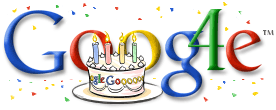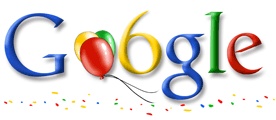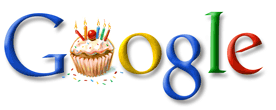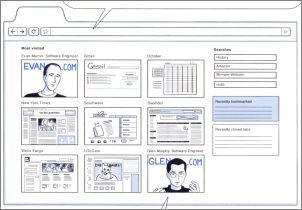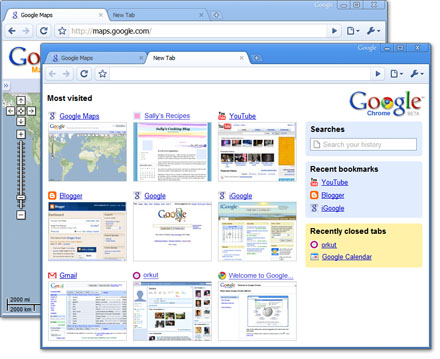1. Focus on the user and all else will follow.
From its inception, Google has focused on providing the best user experience possible. While many companies claim to put their customers first, few are able to resist the temptation to make small sacrifices to increase shareholder value. Google has steadfastly refused to make any change that does not offer a benefit to the users who come to the site:
- The interface is clear and simple.
- Pages load instantly.
- Placement in search results is never sold to anyone.
- Advertising on the site must offer relevant content and not be a distraction.
By always placing the interests of the user first, Google has built the most loyal audience on the web. And that growth has come not through TV ad campaigns, but through word of mouth from one satisfied user to another.
2. It's best to do one thing really, really well.
Google does search. With one of the world's largest research groups focused exclusively on solving search problems, we know what we do well, and how we could do it better. Through continued iteration on difficult problems, we've been able to solve complex issues and provide continuous improvements to a service already considered the best on the web at making finding information a fast and seamless experience for millions of users. Our dedication to improving search has also allowed us to apply what we've learned to new products, including Gmail, Google Desktop, and Google Maps. As we continue to build new products* while making search better, our hope is to bring the power of search to previously unexplored areas, and to help users access and use even more of the ever-expanding information in their lives.
3. Fast is better than slow.
Google believes in instant gratification. You want answers and you want them right now. Who are we to argue? Google may be the only company in the world whose stated goal is to have users leave its website as quickly as possible. By fanatically obsessing on shaving every excess bit and byte from our pages and increasing the efficiency of our serving environment, Google has broken its own speed records time and again. Others assumed large servers were the fastest way to handle massive amounts of data. Google found networked PCs to be faster. Where others accepted apparent speed limits imposed by search algorithms, Google wrote new algorithms that proved there were no limits. And Google continues to work on making it all go even faster.
4. Democracy on the web works.
Google works because it relies on the millions of individuals posting websites to determine which other sites offer content of value. Instead of relying on a group of editors or solely on the frequency with which certain terms appear, Google ranks every web page using a breakthrough technique called PageRank™. PageRank evaluates all of the sites linking to a web page and assigns them a value, based in part on the sites linking to them. By analyzing the full structure of the web, Google is able to determine which sites have been "voted" the best sources of information by those most interested in the information they offer. This technique actually improves as the web gets bigger, as each new site is another point of information and another vote to be counted.
5. You don't need to be at your desk to need an answer.
The world is increasingly mobile and unwilling to be constrained to a fixed location. Whether it's through their PDAs, their wireless phones or even their automobiles, people want information to come to them. Google's innovations in this area include Google Number Search, which reduces the number of keypad strokes required to find data from a web-enabled cellular phone and an on-the-fly translation system that converts pages written in HTML to a format that can be read by phone browsers. This system opens up billions of pages for viewing from devices that would otherwise not be able to display them, including Palm PDAs and Japanese i-mode, J-Sky, and EZWeb devices. Wherever search is likely to help users obtain the information they seek, Google is pioneering new technologies and offering new solutions.
6. You can make money without doing evil.
Google is a business. The revenue the company generates is derived from offering its search technology to companies and from the sale of advertising displayed on Google and on other sites across the web. However, you may have never seen an ad on Google. That's because Google does not allow ads to be displayed on our results pages unless they're relevant to the results page on which they're shown. So, only certain searches produce sponsored links above or to the right of the results. Google firmly believes that ads can provide useful information if, and only if, they are relevant to what you wish to find.
Google has also proven that advertising can be effective without being flashy. Google does not accept pop-up advertising, which interferes with your ability to see the content you've requested. We've found that text ads (AdWords) that are relevant to the person reading them draw much higher clickthrough rates than ads appearing randomly. Google's maximization group works with advertisers to improve clickthrough rates over the life of a campaign, because high clickthrough rates are an indication that ads are relevant to a user's interests. Any advertiser, no matter how small or how large, can take advantage of this highly targeted medium, whether through our self-service advertising program that puts ads online within minutes, or with the assistance of a Google advertising representative.
Advertising on Google is always clearly identified as a "Sponsored Link." It is a core value for Google that there be no compromising of the integrity of our results. We never manipulate rankings to put our partners higher in our search results. No one can buy better PageRank. Our users trust Google's objectivity and no short-term gain could ever justify breaching that trust.
Thousands of advertisers use our Google AdWords program to promote their products; we believe AdWords is the largest program of its kind. In addition, thousands of web site managers take advantage of our Google AdSense program to deliver ads relevant to the content on their sites, improving their ability to generate revenue and enhancing the experience for their users.
7. There's always more information out there.
Once Google had indexed more of the HTML pages on the Internet than any other search service, our engineers turned their attention to information that was not as readily accessible. Sometimes it was just a matter of integrating new databases, such as adding a phone number and address lookup and a business directory. Other efforts required a bit more creativity, like adding the ability to search billions of images and a way to view pages that were originally created as PDF files. The popularity of PDF results led us to expand the list of file types searched to include documents produced in a dozen formats such as Microsoft Word, Excel and PowerPoint. For wireless users, Google developed a unique way to translate HTML formatted files into a format that could be read by mobile devices. The list is not likely to end there as Google's researchers continue looking into ways to bring all the world's information to users seeking answers.
8. The need for information crosses all borders.
Though Google is headquartered in California, our mission is to facilitate access to information for the entire world, so we have offices around the globe. To that end we maintain dozens of Internet domains and serve more than half of our results to users living outside the United States. Google search results can be restricted to pages written in more than 35 languages according to a user's preference. We also offer a translation feature to make content available to users regardless of their native tongue and for those who prefer not to search in English, Google's interface can be customized into more than 100 languages. To accelerate the addition of new languages, Google offers volunteers the opportunity to help in the translation through an automated tool available on the Google.com website. This process has greatly improved both the variety and quality of service we're able to offer users in even the most far flung corners of the globe.
9. You can be serious without a suit.
Google's founders have often stated that the company is not serious about anything but search. They built a company around the idea that work should be challenging and the challenge should be fun. To that end, Google's culture is unlike any in corporate America, and it's not because of the ubiquitous lava lamps and large rubber balls, or the fact that the company's chef used to cook for the Grateful Dead. In the same way Google puts users first when it comes to our online service, Google Inc. puts employees first when it comes to daily life in our Googleplex headquarters. There is an emphasis on team achievements and pride in individual accomplishments that contribute to the company's overall success. Ideas are traded, tested and put into practice with an alacrity that can be dizzying. Meetings that would take hours elsewhere are frequently little more than a conversation in line for lunch and few walls separate those who write the code from those who write the checks. This highly communicative environment fosters a productivity and camaraderie fueled by the realization that millions of people rely on Google results. Give the proper tools to a group of people who like to make a difference, and they will.
10. Great just isn't good enough.
Always deliver more than expected. Google does not accept being the best as an endpoint, but a starting point. Through innovation and iteration, Google takes something that works well and improves upon it in unexpected ways. Search works well for properly spelled words, but what about typos? One engineer saw a need and created a spell checker that seems to read a user's mind. It takes too long to search from a WAP phone? Our wireless group developed Google Number Search to reduce entries from three keystrokes per letter to one. With a user base in the millions, Google is able to identify points of friction quickly and smooth them out. Google's point of distinction however, is anticipating needs not yet articulated by our global audience, then meeting them with products and services that set new standards. This constant dissatisfaction with the way things are is ultimately the driving force behind the world's best search engine.
